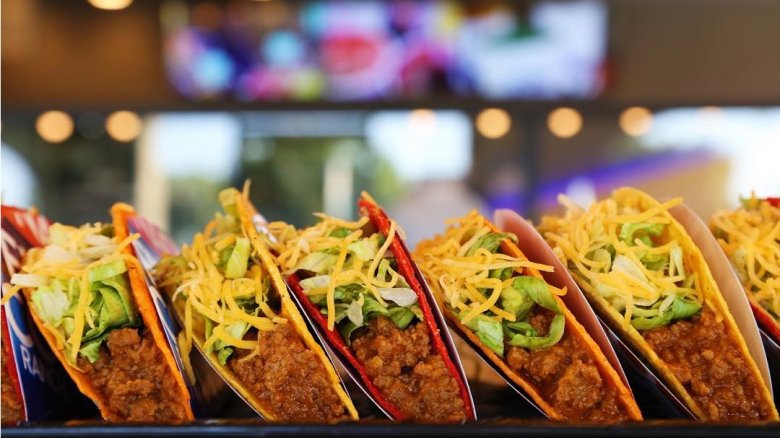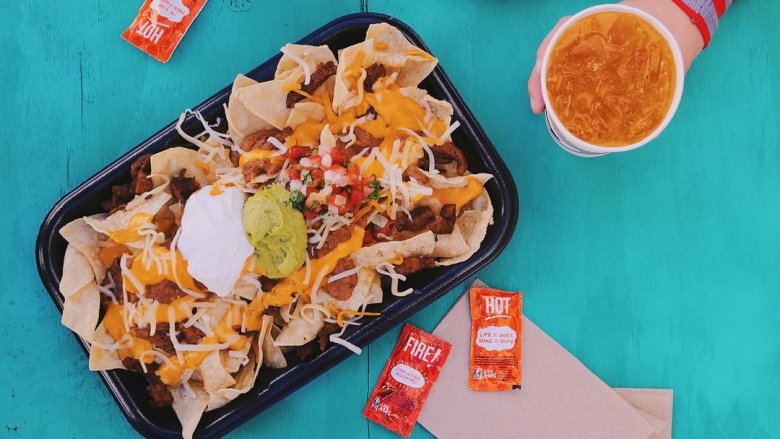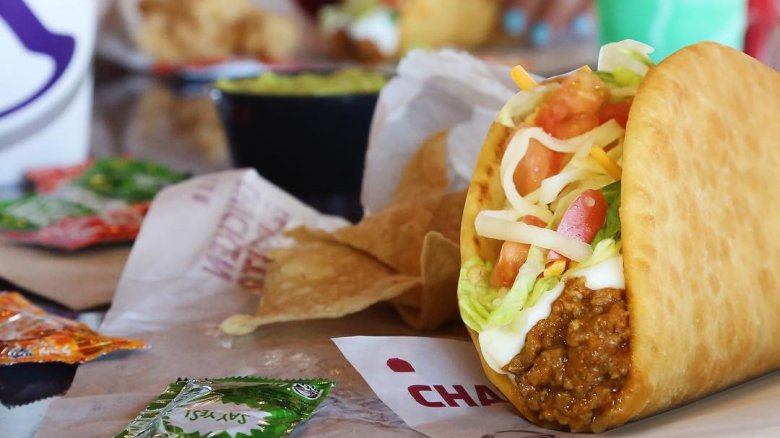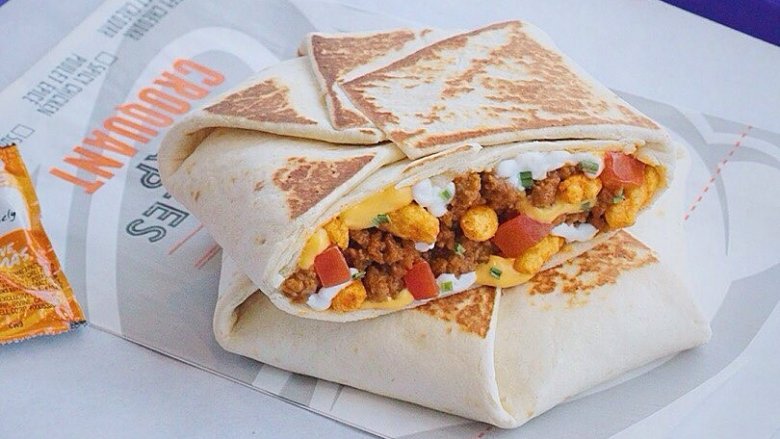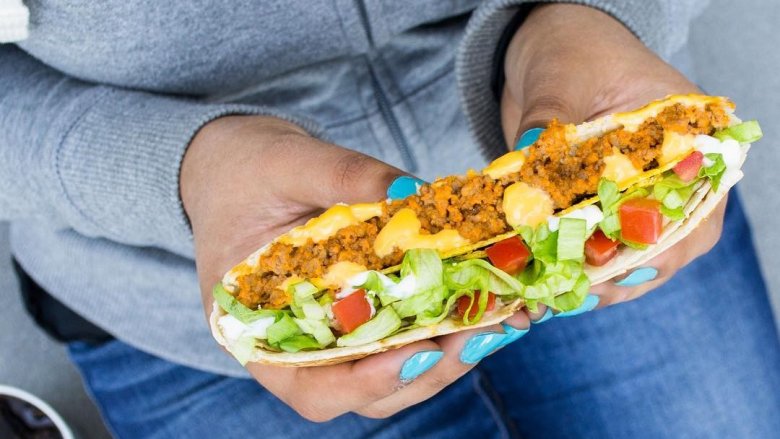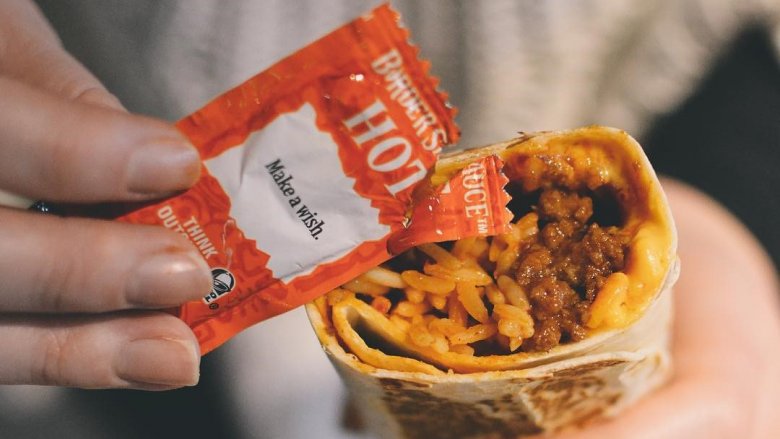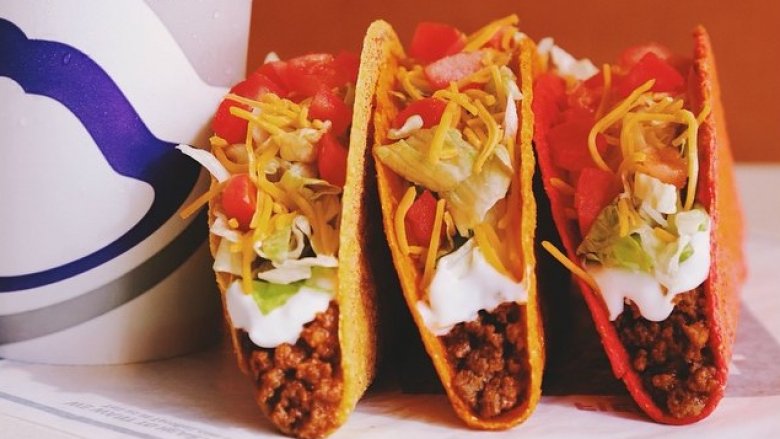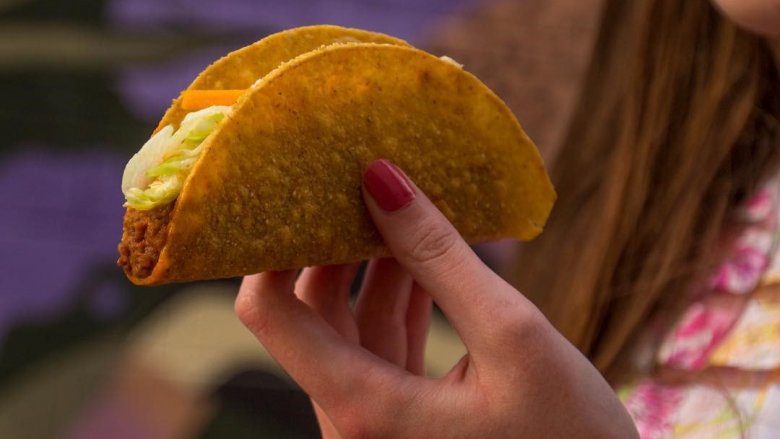The Truth About Taco Bell's "Seasoned Beef"
Even as fast food places go, Taco Bell is pretty polarizing. You either love them or hate them, and either way, you've probably heard the controversy over just what's in those beef tacos. Taco Bell's beef is one of the fast food world's most infamous ingredients, so let's pull back the curtain and look at what you're really getting piled on top of those nachos, wrapped inside your favorite tacos, and covered with oh-so-delicious cheese.
The crazy claims that started it all
First, let's clear something up. There are a ton of urban legends that have been making the rounds at Taco Bell's expense, and we're not just going to tell you they're not true. We're going to tell you why they're not true.
Let's start with the claim that filler — particularly mealworms — is used as a major ingredient. Worms are everywhere, the logic goes, and clearly they're a cheap substitute. According to ThoughtCo., this is false on pretty much all counts. Both earthworms and mealworms are way more expensive than beef, and range anywhere from $10 to $20 a pound. That's more than you pay for beef at the grocery store, and when you factor in Taco Bell's wholesale and bulk pricing discounts, that's way more than they're paying. It's just not good business sense (along with being icky).
The other story is that Taco Bell is serving up "Grade D" beef, a super low-end cut of meat that no one else uses. Snopes says this one is pretty clearly not true, for one major reason: there's no such thing.
They were sued over their ingredients
In 2011, the rumors got so bad an Alabama law firm decided to take legal action to get them to change the way they advertised and labeled their products. According to Jezebel, the firm was insisting the product be labeled "taco meat filling" instead of "seasoned beef," because (they said) it was only about 36 percent actual beef.
According to the lawsuit, that is, and that lawsuit was voluntarily withdrawn by the firm relatively quickly. It was a complicated and messy end to the legal action, though, with the firm issuing only the briefest of statements saying they were just trying to get Taco Bell to divulge their ingredients. Taco Bell, on the other hand, made it clear it was dropped because the claims were insanely false. Fox News said Taco Bell even took out newspaper ads demanding an apology, because the scandal did so much damage to their reputation and their business. Taco Bell CEO Greg Creed said, "... to so falsely and recklessly put these accusations out there and impact all these people is just so unacceptable. I think the public should be outraged."
They spent millions to clear up the numbers
After the lawsuit was dropped, Taco Bell went into damage control mode. They wanted to make sure everyone knew the accusations weren't true, and they spent an insane amount of money to do it. How much? Between $3 and $4 million, according to the Associated Press (via NPR).
That included mostly advertising and videos, clarifying that Taco Bell's now-infamous seasoned beef was actually 88 percent beef. That's better, but that still leaves some percentages unaccounted for. Not surprisingly, people were still been wondering about the rest of the ingredients.
So what's in that other 12 percent?
Taco Bell went for full transparency on this one, not only listing ingredients but telling people why they were included in the meaty mix (via First We Feast). It's all pretty good news, so let's start unpacking just what you're eating when you bite into your beef burrito.
A lot of the ingredients in that other 12 percent are pretty standard stuff. Some — like onion powder, sea salt and salt, chili pepper, tomato powder, and garlic powder — you probably use in your own taco meat. Other ingredients — like oats, yeast extract, and natural smoke flavor — you probably use in your kitchen for other things, but might not typically think of including in your Taco Tuesday preparations. There's still a lot of odd-sounding ingredients on the list, too, so what about them?
Some are more familiar than you think
Let's move on with maltodextrin, which Pop Sugar says is a common additive used as a thickener in many foods, from cereals to salad dressing. It's not as unnatural as it sounds, either: it's made from whole ingredients like corn, rice, and wheat that's cooked then mixed with enzymes that break down the starches.
Next is soy lecithin, and the Huffington Post says it's in almost everything. You'll find it in things from milk chocolate to mayo, and it's so popular because it acts as an emulsifier to bind ingredients (like water and oil) that would otherwise separate. It's also used as a releasing agent (think non-stick cooking spray), as a wetting agent (it makes baking easier) and for cutting back on stickiness and foaminess.
There's lactic acid, too, and SFGate says that's added to a ton of products (particularly dairy, sourdoughs, and fermented goodness) to add a bit of a citrus tang. SFGate looked at sodium phosphate, too, and says getting too much of it can cause issues, but you get such a small amount there's generally no reason to be concerned.
Why do they add cocoa powder?
Of all the ingredients, the ones that might make you pause are a few more commonly associated with sweet than savory. Cocoa powder and caramel color (caramelized sugar) are both on the ingredient list, and according to Taco Bell (via ABC News) they're only there to give the meat a little added color richness. The saying goes that the first bite is with the eye, and that's true in the fast food world, too.
Let's have a chemist's opinion
Let's go to a different sort of expert: Derek Lowe, an organic chemist who's spent decades in the pharmaceutical industry. ABC News got in touch with him when the whole "seasoned beef" thing started going viral and asked him for his opinion on these ingredients, which he posted in full in a piece for Science Translational Medicine.
"As a chemist, ... I'm not going to look at some long chemical name on a list of ingredients and immediately assume I'm being poisoned," he said. "I don't have any patience for the 'Ooh, that's hard to pronounce, so it must be icky' school of thought."
Lowe says in his experience, the food chain is pretty safe. His words of wisdom apply across all foods, and he says that just because something isn't familiar, that doesn't mean it's dangerous. Anything can be made scary. Look at it this way: would you eat (R)-3,4-dihydroxy-5-((S)-1,2-dihydroxyethyl)furan-2(5H)-one? No? Then you'll die of scurvy, because that's Vitamin C.
It's not meat, it's protein
With more and more people trying to find more environmentally-friendly, healthy ways to get their protein, Taco Bell is trying to stay one step ahead of the game with the introduction of their protein Power menu. You're not the only one wondering what's up with that, and Take Part says it's part of their move to offer some healthier alternatives. This particular menu is high-meat, high-protein, low-fat, and low-carb. (It's also unrolling slowly, so there will likely be changes to what you see on offer at Taco Bell today.)
Whether or not anyone needs as much protein as they're packing into each one of these meals is up for debate (and nutritionists seem to suggest we already get plenty of protein already, without going out of our way). But the important part for our sake of argument is that the re-branding isn't Taco Bell going back on their word. It's not an indication that their meat is anything but meat, it's an attempt to seem more healthy and, according to Quartz, pave the way for including alternate, non-meat protein sources in their menu down the road.
There's a bigger problem
In 2015, The Washington Post reported on Taco Bell's real problem with meat. It was one shared by sister companies also operating under the umbrella of Yum! Brands, including Pizza Hut and KFC. While other fast food chains were redoubling their efforts toward responsibly sourced products and their commitment to animal welfare, Yum! was weirdly silent. At the time, they were the only major chain in the US who hadn't put a plan in place for improving their sourcing. In fact, in 2014 CEO Greg Creed went as far as saying it just wasn't possible to switch to sourcing only from farmers who promised to go hormone- and antibiotic-free.
But there is good news. In 2017, six public interest groups (like the Center for Food Safety) graded all your favorite fast food restaurants on their commitment to responsible sourcing (via CNN). Taco Bell earned a B- on their report card, as they've since made significant strides toward making their chicken antibiotic-free. That's progress, at least.
What happened with that horse meat thing?
All right, let's talk about the elephant in the room. Or rather, the horse. In 2013, the world was shocked by the discovery that horse meat had been found in Taco Bell meat. Horse is a legitimate meat source in some countries (like, CBS says, Switzerland, Mexico, Japan, Germany, Belgium, and Poland), but not in the US and much of Europe. Taco Bell announced (via CNN) that they were pulling their beef off the menu after finding it had been tainted with horse meat, but there's an important footnote to the story. The problem was a European one, and since Taco Bell doesn't import any European beef into the States, no US restaurants were at risk.
They weren't the only ones caught up in the scandal, either. USA Today says they were just one name on a long list of companies that included Birds Eye, Nestle, Burger King, IKEA, and Tesco. By the time the fallout had settled, around 99 percent of samples were found to contain no horse whatsoever. Taco Bell's seasoned beef is exactly that: seasoned beef.
